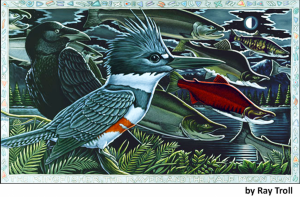Faculty
Alison Styring (ornithology) – styringa@evergreen.edu
Amy Cook (ecology and vertebrate biology)
Program Description
Vertebrate animals represent a diverse and ecologically important component of all life on earth.
They contribute to the vast majority of the described biodiversity on our planet and can be found in
virtually every ecosystem from the deep ocean to the tops of our highest mountains. They are
integral to ecosystem functions at scales small and large. Despite this variation in form and ecology,
vertebrates all share a set of distinctive shared traits. In this program we will gain a broad
understanding of animal diversity and patterns of divergence by reviewing the major groups of
vertebrates – fishes, herptiles, birds, and mammals. This program will investigate the relationship
between form, function, and species interactions to gain a deeper understanding evolutionary
processes and the role of ecology as the interface for evolutionary change. We will map the
appearance and radiation of animals across geologic time and investigate global patterns of climate
and ecosystem distribution and how animal biodiversity relates to those patterns.
Course content will be covered via lectures, workshops, labs, and field outings. We are planning to
have as much learning time as possible in-person. Lectures and workshops will be offered remotely
and we’ll be having at least one field exercise per week and several lab activities over the course of
the quarter. Learning will be evaluated via: periodic assessments of textbook material, field and lab
notebooks, and the final project. Connections between textbook learning and current research will
be made via workshops and a final project.
Students completing the program will gain a foundation in evolutionary processes as they relate to
vertebrates, animal ecology, comparative anatomy and physiology, and introductory concepts
relating to advanced organismal biology, wildlife biology, ecology, and evolution. Field trips will
focus on vertebrate ecology at local field sites including avian foraging ecology, sampling the
distribution of fishes in local streams, and trophic interactions among mammals, birds, and fishes in
Pacific Northwest forests, streams, and marine
Prerequisites:
A minimum of 8 credits of college-level General Biology
Proposed Schedule
Tuesday: 9:00 – 11:00 Lecture/workshop (remote); 12:00 – 2:00 Lecture/workshop (remote)
Wednesday: 10:00 – 12:00 Lecture/workshop (remote)
Thursday: 9:00am – 12:00 Fieldwork (in-person – group A); 1:00pm – 4:00 Fieldwork (in-person – group B)
Friday: 9:00 – 11:00 Lab (in-person – group A); 12:00 – 2:00 Lab (in-person – group B)
Books
Our main textbook is Vertebrates: Comparative Anatomy, Function, Evolution by Kenneth Kardong.
Anything from the sixth edition of this book to the most recent edition will be fine.
We will be reading and discussing a few other books and scientific articles.
